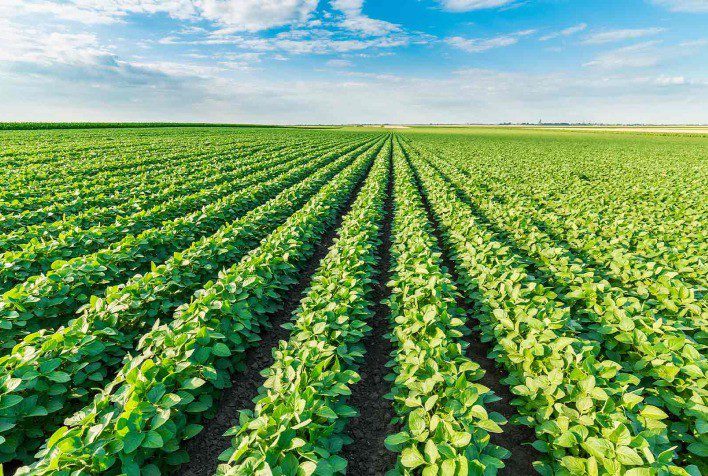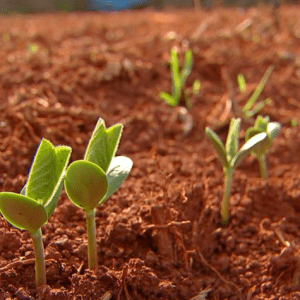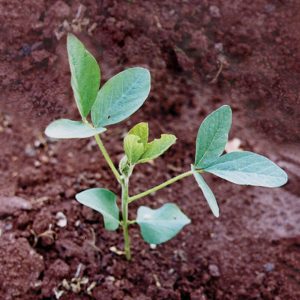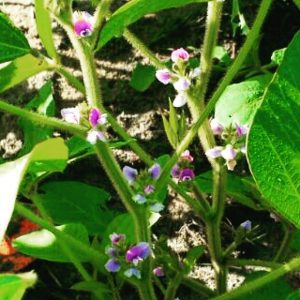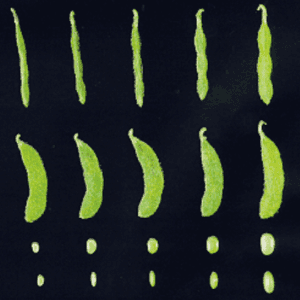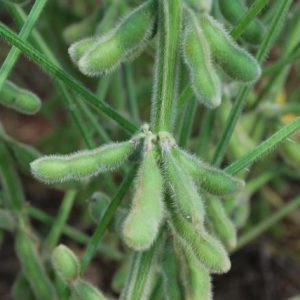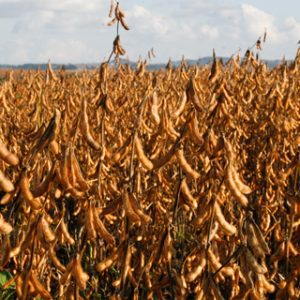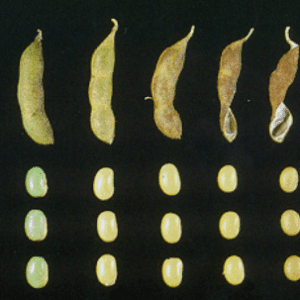Crop Production

Knowing how a soybean plant develops is crucial to growers seeking management practices that can make a crop more sustainable and profitable.
Soybean producers can manage some factors to maximize yield. These include seeding at the right time, maintaining plant density, applying fertilizers, and protecting plants with weed, insect, and disease control. What cannot be controlled is weather conditions, which affect air temperature and solar radiation. Knowing how soybean plants grow can help producers use management practices most effectively to obtain higher yields.
Soybean Plant Growth
Soybean plant growth is divided into vegetative and reproductive stages, each one with morphological characteristics and physiological processes (table 1). Dry weight accumulates in soybeans through photosynthesis as plants manufacture carbohydrates, proteins, and oils, and it is related to environmental conditions. Soybean growth and yield are the result of genetic and environmental interactions during the growth season.
Soybean varieties are classified by their growth habit and daylight requirements to start blooming. Determinate soybeans finish most vegetative growth before flowering, while indeterminate soybeans continue to grow after flowering begins. Maturity groups (MG) are based on the response of soybean varieties to daylight variations from north to south. In the United States, MG 00 varieties are adapted to northernmost areas and MG VIII for southernmost areas.
Table 1. Vegetative and Reproductive Stages of a Soybean Plant*
* Each specific V or R stage is reached when 50% or more of the plants in the field are in or beyond that stage.
| Vegetative Stages | Reproductive Stages |
|---|---|
| VE Emergence | R1 Beginning bloom |
| VC Cotyledon | R2 Full bloom |
| V1 First trifoliolate | R3 Beginning pod |
| V2 Second trifoliolate | R4 Full pod |
| V3 Third trifoliolate | R5 Beginning seed |
| R6 Full seed | |
| R7 Beginning maturity | |
| V(n) Nth trifoliolate | R8 Full maturity |
- Figure 1. Germination and emergence (VE)
- Figure 2. Third trifoliate (V3)
- Figure 3. Full Bloom (R2)
- Figure 4. Filling seed (R5)
- Figure 5. Full seed (R6)
- Figure 6. Full maturity (R8)
- Figure 7. Mature seed (R7-R8)
Table 2 offers a more detailed description of each stage along with management practices. For a soybean field to be considered in a particular stage, at least 50 percent of the plants need to be in or beyond that stage. To determine the correct stage, collect plants from different areas of the field, including at least 10 plants for every 10 acres, to get an average stage of development. Randomly select plants at each site. Avoid choosing only the largest or most vigorous plants. Instead, look for consecutive plants in a row, each with an undamaged main stem.
Being able to accurately identify the growth stages reduces the risk of damaging a field by using an inappropriate management practice. Knowing the correct terminology also helps when discussing soybean development with other professionals. For example, if a herbicide treatment is recommended before soybeans reach the six-leaf stage, you need to identify which leaves are included so that proper identification of the stage can be made; otherwise, misapplication of the product may occur.
Table 2. Soybean Growth Stages and Management Practices
| Stage | Title | Description | Management Practices |
|---|---|---|---|
| VE | Emergence | Cotyledons are above the soil surface, and primary and lateral root growth begins. | Check stand and uniformity. If stand is poor, replanting may be needed. |
| VC | Cotyledon | Unifoliolate leaves are unrolled sufficiently so that leaf edges are not touching. | Keep checking for stand. Cotyledons must be green and attached to the plant, and the terminal must be healthy. |
| V1 | First trifoliolate | Trifoliolate leaf is unrolled (fully developed unifoliate leaves are at the unifoliate node). | Scout for early season insects, diseases, and weeds. |
| V2 | Second trifoliolate | Two trifoliolates are unrolled (one fully developed trifoliolate leaf is above the unifoliate node). Nodulation begins. | Scout for early season insects, diseases, and weeds. Early weed competition can severely affect yield. Apply postemergence herbicides if needed. Check for nodules (should be pink inside). |
| V3–Vn | Third trifoliolate | Three trifoliolates are unrolled. N trifoliolates are unrolled. Root system continues to grow and can fully occupy space between rows. | Scout for insects and diseases. Spray pesticides if needed. |
| R1 | Beginning bloom | Flowering begins. Plant has one flower open at any node on the main stem. | Scout for insects and diseases. Spray pesticides if needed. |
| R2 | Full bloom | The plant has one open flower on one of the two uppermost nodes on the main stem that have a fully developed leaf. Nodulation reaches its maximum activity (first peak). | Scout for insects and diseases. Identify water stress, which affects number of viable flowers. If available, irrigation is critical at this stage |
| R3 | Beginning pod | Pods are 3/16 inch long on one of the four uppermost nodes on the main stem with a fully developed leaf. | Scout for insects and diseases. Identify water stress, which affects pod formation. If available, irrigation is critical at this stage through R6. |
| R4 | Full pod | Pods are 3/4 inch long on one of the four uppermost nodes on the main stem with a fully developed leaf | Scout for insects and diseases. Spray pesticides if needed. |
| R5 | Beginning seed | Seed is 1/8 inch long in one of the four uppermost nodes on the main stem. Nodulation increases its activity again; more nodules appear (second peak). | Scout for insects and diseases. Late-season diseases can severely affect yield. |
| R6 | Full seed | Pods contain green seeds completely filling the cavity in one of the four uppermost nodes on the main stem. | Scout for insects and diseases. Late-season insects can severely affect yield. |
| R7 | Beginning maturity | One normal pod on the main stem has reached mature pod color. | Scout for green stem syndrome (green stems but mature seeds). Other issues include lodging, sprouting seeds, and pod shattering |
| R8 | Full maturity | 95% of pods have reached mature pod color. Generally, this is 5 to 10 days before harvest (15% moisture). | If plants are still green, harvest slowly with equipment in excellent operating condition. |
Reference
Fehr, W. R., and C. E. Caviness. 1977. “Stages of Soybean Development.” Special Report 87.
 Eros Francisco, Extension Grain Crops Specialist, Assistant Professor, Crop, Soil, and Environmental Sciences, Auburn University.
Eros Francisco, Extension Grain Crops Specialist, Assistant Professor, Crop, Soil, and Environmental Sciences, Auburn University.
New April 2022, How a Soybean Plant Develops, ANR-2883

